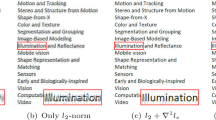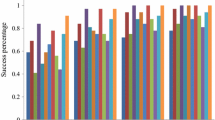Abstract
We focus on blind image deconvolution, which has attracted intensive attentions since Fergus et al.’s influential work in 2006. Among the current literature, the daring idea of imposing the normalized sparsity measure on blind image deblurring is a recent spotlight, which is, nevertheless, far from practical use in terms of estimating accuracy, efficiency, as well as robustness. To boost its performance, we propose a novel method via coupling the normalized sparsity measure with the total generalized variation, which, however, does not fit the blind deblurring problem. By use of operator splitting and alternating direction method of multipliers, a numerical scheme is derived, leading to a more accurate, efficient, and robust blind deblurring algorithm. Numerous blind deblurring results on both benchmark data and real-world blurred images demonstrate the competitive or even better performance compared against the state of the art.






Similar content being viewed by others
Notes
Since March, 2013, the authors of [15] have successively released two executable software (implemented in C++) for blind motion deblurring, i.e., Robust Motion Deblurring System. The first version is v3.0.1 which implements the algorithm as detailed in [15], and the second version is v3.1 which incorporates the algorithms in both [15] and [14] for more accurate blur kernel estimation. The notation [15+14] means that we use the second version, i.e., v3.1, to produce the deblurred images.
References
Chambolle, A., Lions, P.-L.: Image recovery via total variation minimization and related problems. Numer. Math. 76, 167–188 (1997)
Fergus, R., Singh, B., Hertzmann, A., Roweis, S.T., Freeman, W.: Removing camera shake from a single photograph. ACM Trans. Graph. 25(3), 787–794 (2006)
Babacan, S.D., Molina, R., Katsaggelos, A.K.: Variational Bayesian blind deconvolution using a total variation prior. IEEE Trans. Image Process. 18(1), 12–26 (2009)
Shao, W.-Z., Deng, H.-S., Ge, Q., Li, H.-B., Wei, Z.-H.: Regularized motion blur-kernel estimation with adaptive sparse image prior learning. Pattern Recognit. 51, 402–424 (2016)
Levin, A., Weiss, Y., Durand, F., Freeman, W.T.: Efficient marginal likelihood optimization in blind deconvolution. IEEE CVPR (2011). doi:10.1109/CVPR.2011.5995308
Levin, A., Weiss, Y., Durand, F., Freeman, W.T.: Understanding blind deconvolution algorithms. IEEE Trans. Pattern Anal. Mach. Intell. 33(12), 2354–2367 (2011)
Chan, T.F., Wong, C.K.: Total variation blind deconvolution. IEEE Trans. Image Process. 7(3), 370–375 (1998)
Liao, H., Ng, M.K.: Blind deconvolution using generalized cross-validation approach to regularization parameter estimation. IEEE Trans. Image Process. 20, 670–680 (2011)
Kotera, J., Sroubek, F., Milanfar, P.: Blind deconvolution using alternating maximum a posteriori estimation with heavy-tailed priors. R. Wilson et al. (eds.): CAIP, Part II, LNCS 8048, pp. 59–66. (2013). doi:10.1007/978-3-642-40246-3-8
Cho, S., Lee, S.: Fast motion deblurring. ACM Trans. Graph. 28(5), 145 (2009)
Liu, R.W., Wu, D., Wu, C.S., Xiong, N.X.: Hybrid regularized Blur Kernel estimation for single-image blind deconvolutionl’. IEEE SMC (2015). doi:10.1109/SMC.2015.318
Krishnan, D., Tay, T., Fergus, R.: Blind deconvolution using a normalized sparsity measure. IEEE CVPR (2011). doi:10.1109/CVPR.2011.5995521
Shan, Q., Jia, J., Agarwala, A.: High-quality motion deblurring from a single image. ACM Trans. Graph. 27, 3 (2008)
Xu, L., Jia, J.: Two-phase kernel estimation for robust motion deblurring. ECCV 6311, 157–170 (2010). doi:10.1007/978-3-642-15549-9_12
Xu, L., Zheng, S., Jia, J.: Unnatural \(L_{0}\) sparse representation for natural image deblurring. IEEE CVPR (2013). doi:10.1109/CVPR.2013.147
Daniele, P., Paolo, F.: Total variation blind deconvolution: the devil is in the details. IEEE CVPR (2014). doi:10.1109/CVPR.2014.372
Welk, M., Raudaschl, P., Schwarzbauer, T., et al.: Fast and Robust linear motion deblurring. Signal Image Video Process. 9, 1221 (2015)
Kerouh, F., Serir, A.: Wavelet-based blind blur reduction. Signal Image Video Process. 9, 1587 (2015)
Wang, W., Ng, M.K.: Convex regularized inverse filtering methods for blind image deconvolution. Signal Image Video Process. (2016). doi:10.1007/s11760-016-0924-3
Wang, R., Tao, D.: “Recent progress in image deblurring.” arXiv:1409.6838, unpublished
Bredies, K., Kunisch, K., Pock, T.: Total generalized variation. SIAMJ Imaging Sci. 3(3), 492–526 (2010)
Sun, Y., Li, Z., Wu, M.: A rank-constrained matrix representation for hypergraph-based subspace clustering. Math. Probl. Eng. 3, 1–12 (2015)
Money, J.H., Kang, S.H.: Total variation minimizing blind deconvolution with shock filter reference. Image Vis. Comput. 26(2), 302–314 (2008)
Lysaker, O.M., Tai, X.-C.: Iterative image restoration combining total variation minimization and a second-order functional. Int. J. Comput. Vis. 66, 5–18 (2006)
Chan, T.F., Marquina, A., Mulet, P.: Higher order total variation-based image restoration. SIAM J. Sci. Comput. 22(2), 503–516 (2000)
Krishnan, D., Fergus, R.: Fast image deconvolution using hyper-laplacian priors. Adv. Neural Inf. Process. Syst. Proc. Conf. 22, 1033–1041 (2009)
Acknowledgements
We would like to show our gratitude to the anonymous reviewers for their serious, pertinent, and very helpful comments on the manuscript. This research was supported in part by the Natural Science Foundation (NSF) of China (61402239, 61302178, 61602257), the NSF of Jiangsu Province (BK20130868, BK20160904), and the NSF of Guangxi Province (2014GXNSFAA118360), the NSF for Jiangsu Institutions (15KJB520028, 16KJB520035), and the Jiangsu Key Lab. of Image and Video Understanding for Social Safety (Nanjing University of Science and Technology, 30920140122007).
Author information
Authors and Affiliations
Corresponding author
Rights and permissions
About this article
Cite this article
Yang, CX., Shao, WZ. & Huang, LL. Boosting normalized sparsity regularization for blind image deconvolution. SIViP 11, 681–688 (2017). https://doi.org/10.1007/s11760-016-1010-6
Received:
Revised:
Accepted:
Published:
Issue Date:
DOI: https://doi.org/10.1007/s11760-016-1010-6




